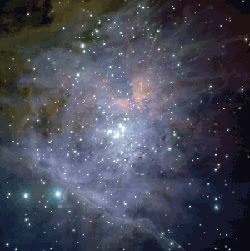Paula M. Powell, Senior Editor
What a difference a year -- or two -- makes with imaging technology. First-generation cell-phone cameras, for example, primarily used CCD sensors, but the cost benefits of CMOS technology, as well as increasing consumer demand for smaller handheld units, soon changed things. Borrow any teenager's high-tech cell phone to take a picture, and the odds are that the camera relies on a CMOS imager on a chip.
 To expand the frame of reference, consider recent imaging advances in astronomy. As early as 1996, scientists working with the 2.2-m telescope at Mauna Kea, Hawaii, used a 1024 X 1024-pixel IR imager based on CMOS technology from Rockwell Scientific Co. in Camarillo, Calif., to capture images of the Shoemaker-Levy comet collision with Jupiter. In 2000, the company delivered the first 2048 X 2048-pixel IR array for an astronomy research program led by the University of Hawaii. The 4.2-megapixel device, which increased CMOS transistor count to more than 13 million, featured random noise of less than 5 e, which Rockwell scientists say was on a par with that of the highest-performance CCDs of the time.
To expand the frame of reference, consider recent imaging advances in astronomy. As early as 1996, scientists working with the 2.2-m telescope at Mauna Kea, Hawaii, used a 1024 X 1024-pixel IR imager based on CMOS technology from Rockwell Scientific Co. in Camarillo, Calif., to capture images of the Shoemaker-Levy comet collision with Jupiter. In 2000, the company delivered the first 2048 X 2048-pixel IR array for an astronomy research program led by the University of Hawaii. The 4.2-megapixel device, which increased CMOS transistor count to more than 13 million, featured random noise of less than 5 e, which Rockwell scientists say was on a par with that of the highest-performance CCDs of the time.
Cell phones and large telescopes essentially represent two far-flung ends of the application spectrum for imaging sensors. High-volume consumer applications often demand low-cost manufacturing capability, less power draw and on-chip integration -- key strengths of CMOS. Higher-performance scientific and astronomical applications often take place in less than optimal lighting conditions and thus have long been a bastion of CCD imaging sensors, designed with this in mind.
One might draw the following conclusion about the future of CMOS technology. It will most likely win hands down against CCD imagers in applications demanding high-volume, low-cost, decent-quality imaging, such as miniature cameras and surveillance systems. For instance, the capability to switch almost instantaneously between quality color photography and streaming video is outside the realm of CCD architectures. CMOS will also continue making inroads in high-performance applications, from DNA analysis to astronomy, but will most likely not displace CCD technology altogether because the right mix of quantum efficiency, noise level, fill factor, etc., is still possible only with the latter sensors. The following series of articles will explore these issues in more detail.